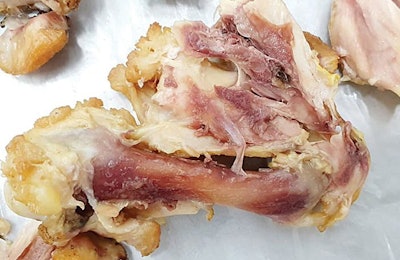
Demand for chicken breast over recent decades has grown enormously and broiler producers have been able to successfully respond, but this growth has not been without its challenges for poultry processors.
Today’s modern broilers produce more meat over shorter periods than earlier breeds and are sent to slaughter at a younger age - from 35 to 36 days and at average weights of 2 kg.
Handling faster growing birds has consequences for poultry processors who must adapt to a variety of factors associated with this change if output is not going to be reduced.
Young skin
The skin of younger birds will be weaker than older broilers and feather coverage may be incomplete at the time of slaughter. This may have negative consequences in a number of instances, impacting the eventual quality of the processed bird.
During capture and caging, birds will try to escape should they become stressed by the harvesting team. This can lead to intense wing flapping and also to the birds piling on top of each other when their escape route is blocked. Birds on the top of the pile will dig their claws into those below in an attempt to prevent themselves from falling.
Inevitably, this will lead to skin being scratched, wings being bruised, and breast muscles suffering both bruises and bleeds.
The skin of younger birds is more vulnerable. Scratches that occur during rearing and that come into contact with the bedding may lead to cellulitis.
In the processing plant, should the operations before plucking not be performed carefully, skin issues will only become apparent after the birds exit the last plucker when scratches to the upper part of the thigh and breast and any other areas that are not fully feathered come to light.

Damage to skin may only become evident once birds exit the last plucker. (Eduardo Cervantes López)
Varying sizes
Many plants process two different weights of birds, from small and medium through to large. This can present challenges for the manufacturers of plucking machines. Any downtime needed to adjust from one bird size to another will come at a cost.
If young birds are being processed, softer plucking fingers will be needed because they don't cause as much friction as the harder fingers used on older birds and, therefore, will be less likely to damage the skin of the breast area.
To help protect the skin of younger birds, prior to being sent to slaughter, some companies add skin strengthening additives to the flock’s feed.
Changing proportions
The preference for larger birds has increased and, where large birds were once the exception, they have now become the norm.
As modern broilers have developed, the percentage of the breast relative to other parts of the body has increased.

The percentage of breast, and some other cuts, increases with the size of the broiler. (Eduardo Cervantes López, Broiler Meat Signals and WATT Global Media)
The table above shows not only that the dry yield of heavier birds is greater than that of lighter birds but also that the percentage of breast meat goes up as does the thigh yield. The percentage yield of drumsticks, however, remains constant.
The legs of today’s, larger birds tend to be thicker and this may present problems when they are hung on the shackles. Given the shackles’ rigidity, larger legs may not fit snugly into the very bottom of them.
This can lead to an increase in the number of birds falling from them during passage from the hanging to the plucking area. Many of these fallen birds cannot be returned into the processing line and so the final yield decreases.
Today’s faster-growing birds are also more prone to breast and dorsal myopathies and larger birds tend to spend more time lying down, leading to skin burns. All of these issues can increase the number of rejected birds at the plant.
Black bone syndrome
Black bone syndrome is another consequence of the rapid growth of today’s broilers and the result of the muscles developing more quickly than bones. The fragility and malformation of the bone structure is a consequence of lower mineralization in younger birds’ bones.
More common in males than in females, due to the bones of males being more porous, the condition can lead to the emergence of blood along wing and thigh bones leading to customer rejection.

















